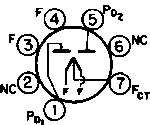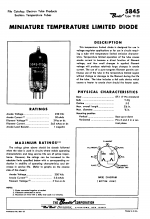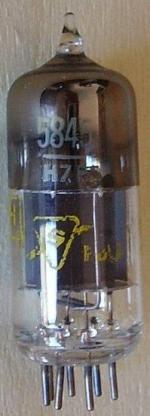
5845
|
|
|||||||||||||||||||||||||||||||||||
|
Hits: 2723 Replies: 0
5845 curve traces in Gammatron mode
|
|
|
Joe Sousa
09.Sep.12 |
1
Fellow Radiophiles: Finding Gammatron-like structures in tubes has become a hobby pursuit of some tube enthusiasts, myself included. Danial Stocks in the Tube Collector's Association Yahoo news group suggested the dual noise diode type 5845/TT-30 as a candidate for (mis)use as a Gammatron. The Gammatron configuration triode is one where there is a cathode, which is preferably filamentary, surrounded by two plates. One plate serves as the conventional triode plate, while the other serves as control element in an analogous fashion to a control grid. Gammatron was a trade named by Heintz and Kaufman, who commercialized a line of transmitting Gammatron structured triodes before World War II. However, the plate-cathode-plate structure was already included in Lee DeForest's triode Patent from 1908. Dual rectifiers, like some versions of the 6AX5GT, or the 1zh37b pentode have been successfully misused in Gammatron mode by hobbyists to build working RF oscillators and amplifiers. The transconductance is usually under 1mS and the mu is usually also a very low <3 and often less than 1. In the design application, the 5845 operates as a pair of diodes with temperature limited emission, as opposed to space-charge limited emission that is used for nearly all tubes. Under temperature limited emission, nearly all electrons that are emitted from the cathode are swept to the cathode and do not form a space charge around the cathode. Temperature limited emission has the characteristic flat topped current source profile. The space charge in conventional tubes serves to greatly reduce the thermal agitation of electrons emitted from the cathode. One can think of the space charge as a holding or averaging tank of electrons. But if there is no space charge reservoir to quiet the turbulent electron emission, the anode current will be very noisy. This is the reason why noise generating diodes operate under temperature limited emission. The following curve traces show the 5845 under Gammatron mode with one plate voltage swept on the horizontal axis, while the voltage on the other plate is stepped through twelve -2V steps. The low transconductance pushed the various curves together so that the usual looping that occurs for a given step overlaps with it's neighbour. ( The vertical current scale for all plots is in uA, despite the uV indication.) These photos show only the first 50V of the plate characteristic that is still under space charge limited emission in the steep portion of the curves. The flat top part of the curves shows thermally limited emission. Also note that space charge operation is necessary for control by our misused second plate which is stepped in -2V steps. The first plot shows operation with the center-tapped filament driven with 2.5V in shunt mode, while the other two plots show operation with the filament fed in series with 5V and 4V. It does not take much plate voltage to draw all available electrons from the cathode when the filament voltage is reduced to 4V. The intrinsic voltage gain mu is 0.6, 0.8, 1 for each of the three plots. The transconductance (gm) is 50uS, 65uS, 25uS respectively. These are all very low values, but the mu near 1 is expected for a symmetric Gammatron structure. The 1zh37b pentode in Gammatron operation has a transconductance of 600uS with 9V at the plate. Much of the higher gm of the 1zh37b Gammatron has to do with the higher emission of the coated cathode and the tighter plate-filament spacing. The gap between the 5845 plates is on the order of 3mm (0.1inches), while the gap between the Gammatron plates of the 1zh37b is on the order of 0.3mm. Those who have sucessfully misused the 6AX5GT in Gammatron operation as an amplifier or oscillator have also obtained low values of the transconductance, on the order of 100uS. Reduced heater voltage on the 6AX5GT helps boost gm by reshaping the space charge for control by one of the diode plates. In the case of the 5845 and 1ZH37B, the highest Gammatron mode gm is obtained with full filament voltage because there is little benefit in reshaping (thinning) the space charge for increased control; the drop in emission with reduced filament voltage more than overtakes any improved control. Thinning down the space charge only improves the intrinsic voltage gain mu, which is higher under lower filament voltage as seen in the third figure. Mu=0.8 under full filament voltage Vf=5V, but it rises to 1 with Vf=4V. At full 5V operating voltage, the 5845 pure tungsten filament glows white-hot; even brighter than a conventional low power (<40W) hard vacuum light bulb. The data sheet also shows curves for the life of the filament as a function of voltage and it is greatly reduced to just 300 hours with 5V. Full brightness incandescent bulbs (>60W) have an atmosphere that prevents filament sputtering and lengthens bulb life, while lower power bulbs operate without an atmosphere, but must also operate at a lower temperature with the resulting more redish color to obtain reasonable bulb life. Best Regards, -Joe |
End of forum contributions about this tube
| Data Compliance | More Information |







